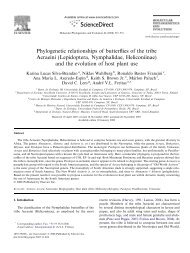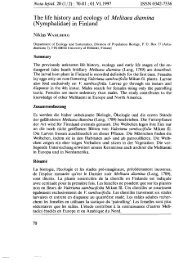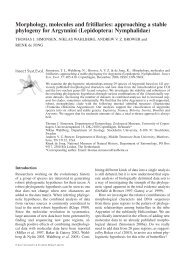Varying rates of diversification in the genus Melitaea (Lepidoptera ...
Varying rates of diversification in the genus Melitaea (Lepidoptera ...
Varying rates of diversification in the genus Melitaea (Lepidoptera ...
Create successful ePaper yourself
Turn your PDF publications into a flip-book with our unique Google optimized e-Paper software.
VARYING RATE OF SPECIATION IN MELITAEA 357<br />
conclusions, o<strong>the</strong>r than what is considered to be M.<br />
didyma may well be a series <strong>of</strong> cryptic species. The<br />
clade <strong>of</strong> most <strong>in</strong>terest is <strong>the</strong> one that began diverg<strong>in</strong>g<br />
dur<strong>in</strong>g <strong>the</strong> late Tortonian, after <strong>the</strong> ancestor <strong>of</strong> M.<br />
g<strong>in</strong>a had branched <strong>of</strong>f <strong>the</strong> stem l<strong>in</strong>eage (Fig. 3).<br />
This clade is very difficult morphologically, with<br />
many forms be<strong>in</strong>g described (Higg<strong>in</strong>s, 1941), and our<br />
molecular results do not shed much light on species<br />
delimitations ei<strong>the</strong>r. A larger sampl<strong>in</strong>g <strong>of</strong> populations<br />
<strong>of</strong> all species would be necessary to f<strong>in</strong>d any consistent<br />
patterns.<br />
EVOLUTIONARY HISTORY OF THE GENUS MELITAEA<br />
Our results on <strong>the</strong> times <strong>of</strong> divergences with<strong>in</strong> <strong>the</strong><br />
<strong>genus</strong> <strong>Melitaea</strong> are <strong>of</strong> course cont<strong>in</strong>gent on <strong>the</strong> calibrations<br />
that we used for estimat<strong>in</strong>g <strong>the</strong>se times. In<br />
this case, we have used secondary calibration po<strong>in</strong>ts<br />
taken from a study that was based on fossil evidence<br />
(Wahlberg, 2006). This approach has been used to<br />
<strong>in</strong>vestigate <strong>the</strong> evolutionary history <strong>of</strong> o<strong>the</strong>r groups <strong>of</strong><br />
species <strong>in</strong> <strong>the</strong> subfamily Nymphal<strong>in</strong>ae, to which <strong>Melitaea</strong><br />
belongs, such as Junonia (Kodandaramaiah &<br />
Wahlberg, 2007) and <strong>the</strong> subtribe Phyciod<strong>in</strong>a (Wahlberg<br />
& Freitas, 2007).<br />
Our analysis has highlighted a repeated pattern <strong>in</strong><br />
<strong>the</strong> evolutionary history <strong>of</strong> <strong>the</strong> <strong>genus</strong> <strong>Melitaea</strong>, which<br />
is that narrowly distributed species are found <strong>in</strong><br />
clades that are <strong>of</strong>ten restricted to particular geographic<br />
areas. If <strong>the</strong> events <strong>of</strong> range extension are<br />
rare, it is likely that some <strong>in</strong>termittent mechanisms<br />
are act<strong>in</strong>g and understand<strong>in</strong>g <strong>the</strong>m appears to be<br />
essential. Thus, our phylogenetic reconstruction<br />
shows, for example, that <strong>the</strong> species <strong>of</strong> two groups are<br />
found only <strong>in</strong> mounta<strong>in</strong>ous zones: <strong>the</strong> fergana group<br />
is constituted only <strong>of</strong> populations <strong>of</strong> butterflies from<br />
Central Asiatic mounta<strong>in</strong> ranges and <strong>the</strong> arcesia<br />
group comprises almost exclusively species which are<br />
endemic to <strong>the</strong> Tibetan Plateau region. Fur<strong>the</strong>rmore,<br />
<strong>the</strong> dat<strong>in</strong>g estimates that <strong>the</strong>se two <strong>in</strong>dependent<br />
groups are contemporary with <strong>the</strong> ma<strong>in</strong> Himalayan<br />
and Tibetan Plateau uplift. We <strong>in</strong>terpret this, on one<br />
hand, as <strong>the</strong> mounta<strong>in</strong> ranges hav<strong>in</strong>g been colonized<br />
early <strong>in</strong> <strong>the</strong>ir geological history and, on <strong>the</strong> o<strong>the</strong>r<br />
hand, <strong>the</strong> ‘door <strong>of</strong> <strong>the</strong> colonization process’ has been<br />
closed after <strong>the</strong> ancestral populations became established<br />
<strong>the</strong>re.<br />
The uplift <strong>of</strong> <strong>the</strong> Himalayan range has been contemporary<br />
with a dramatic cool<strong>in</strong>g <strong>in</strong> <strong>the</strong> climate<br />
<strong>in</strong> Eurasia and evidence correlates <strong>the</strong> two events<br />
toge<strong>the</strong>r (Sharma et al., 1999; Lavé & Avouac, 2001;<br />
Fang et al., 2002). However, prior to <strong>the</strong> cool<strong>in</strong>g, <strong>the</strong><br />
climate on Earth had reached a temperature<br />
optimum for <strong>the</strong> Miocene which lasted for approximately<br />
3 million years with temperatures on average<br />
5 °C higher than presently (late Burdigalian/<br />
Langhian ages) (Zachos et al., 2001; Bohme, 2003).<br />
Dur<strong>in</strong>g this period, <strong>the</strong> number <strong>of</strong> species <strong>in</strong>creased<br />
significantly <strong>in</strong> <strong>the</strong> <strong>genus</strong> and, by assum<strong>in</strong>g a constant<br />
rate <strong>of</strong> ext<strong>in</strong>ction <strong>in</strong> <strong>the</strong> l<strong>in</strong>eages, we can <strong>in</strong>terpret<br />
this correlation as a <strong>diversification</strong> <strong>of</strong> l<strong>in</strong>eages <strong>in</strong><br />
conjunction with a rise <strong>in</strong> <strong>the</strong> temperature. A possible<br />
explanation for <strong>the</strong> rise <strong>in</strong> species numbers could be<br />
that <strong>the</strong> change <strong>in</strong> <strong>the</strong> temperatures opened new<br />
niches for <strong>the</strong> populations <strong>of</strong> butterflies (e.g. changes<br />
<strong>in</strong> host plant distributions and open<strong>in</strong>g <strong>of</strong> high elevation<br />
mounta<strong>in</strong> passes to <strong>the</strong> butterflies) and, consequently,<br />
selective forces or drift could have acted<br />
on newly geographically/ecologically isolated populations.<br />
This explanation is re<strong>in</strong>forced by <strong>the</strong> previous<br />
observation which concerned <strong>the</strong> mounta<strong>in</strong>ous populations<br />
(arcesia and fergana groups). In both cases, it<br />
appears that <strong>the</strong> settlement <strong>of</strong> one population prevented<br />
o<strong>the</strong>r closely-related species to settle afterwards;<br />
just as if <strong>the</strong> quantitatively limited suitable<br />
niches were all rapidly exploited. It has been argued<br />
that <strong>the</strong> first population that fills a newly available<br />
environment disperses and reproduces exponentially,<br />
whereas those arriv<strong>in</strong>g beh<strong>in</strong>d can only do it logistically<br />
(Hewitt, 2000).<br />
As noted previously, between <strong>the</strong> late Langhian and<br />
<strong>the</strong> end <strong>of</strong> <strong>the</strong> Serravallian <strong>the</strong> temperatures dropped<br />
globally on earth, by 4 °C <strong>in</strong> 6 million years (Zachos<br />
et al., 2001). Concern<strong>in</strong>g <strong>the</strong> evolutionary history <strong>of</strong><br />
<strong>the</strong> <strong>Melitaea</strong> butterflies, <strong>the</strong> number <strong>of</strong> species<br />
rema<strong>in</strong>ed almost stable with no noticeable turn <strong>in</strong> <strong>the</strong><br />
slope dur<strong>in</strong>g <strong>the</strong> major part <strong>of</strong> <strong>the</strong> period. The next<br />
upturn takes place at <strong>the</strong> beg<strong>in</strong>n<strong>in</strong>g <strong>of</strong> <strong>the</strong> Tortonian<br />
(Fig. 3) when <strong>the</strong> cont<strong>in</strong>uous decrease <strong>in</strong> <strong>the</strong> temperature<br />
co<strong>in</strong>cides with <strong>the</strong> aridification <strong>of</strong> <strong>the</strong> climate <strong>in</strong><br />
Eurasia and a subsequent expansion <strong>of</strong> grassland<br />
(Pagani, Freeman & Arthur, 1999; Maki et al., 2003).<br />
The displacement <strong>of</strong> largely C 3 vegetation, probably<br />
semi-deciduous forest, by C4 grasslands is probably<br />
cont<strong>in</strong>entwide (Quade et al., 1995). It is likely that<br />
<strong>the</strong> open<strong>in</strong>g <strong>of</strong> <strong>the</strong> vegetal cover has had a positive<br />
impact on butterfly populations <strong>in</strong> general (Peña &<br />
Wahlberg, 2008), and <strong>Melitaea</strong> species <strong>in</strong> particular,<br />
because <strong>the</strong>y are generally found <strong>in</strong> open habitats<br />
such as meadows and disturbed habitats (Wahlberg,<br />
2001).<br />
This mechanism <strong>of</strong> isolation <strong>of</strong> populations based<br />
on major paleoenvironmental change can also be identified<br />
as an ongo<strong>in</strong>g process <strong>in</strong> <strong>the</strong> more proximate<br />
part <strong>of</strong> <strong>the</strong> ultrametric tree. Repeated patterns <strong>of</strong><br />
divergence between populations from Eurasia and<br />
North Africa can be observed, all tak<strong>in</strong>g place <strong>in</strong> a<br />
relatively recent geologic time (after 8 Mya). The use<br />
<strong>of</strong> a unique calibration po<strong>in</strong>t at <strong>the</strong> base <strong>of</strong> <strong>the</strong> phylogeny,<br />
<strong>the</strong> obvious impossibility to <strong>in</strong>clude ext<strong>in</strong>ct<br />
taxa, <strong>the</strong> unexhaustive sampl<strong>in</strong>g <strong>of</strong> extant l<strong>in</strong>eages,<br />
<strong>the</strong> limited amount <strong>of</strong> molecular data, and <strong>the</strong><br />
© 2009 The L<strong>in</strong>nean Society <strong>of</strong> London, Biological Journal <strong>of</strong> <strong>the</strong> L<strong>in</strong>nean Society, 2009, 97, 346–361





